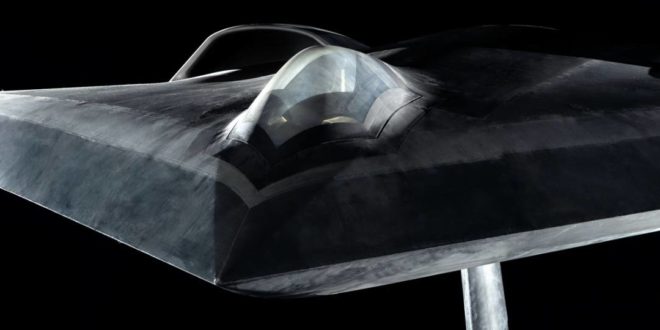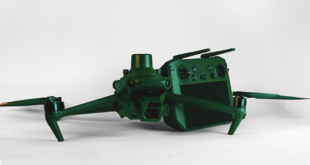Airbus has lifted the veil on its Low-Observable UAV Testbed (LOUT) program, which it has been working on in “Skunk Works”-like secrecy since 2007. The program has recently completed its “iterative camouflage optimization” phase, prompting Airbus and the German defense ministry to partially lift the lid on the project and provide some details about the program. The non-flying testbed was shown to media in carefully controlled conditions while it was mounted on a pole in a radar cross-section (RCS) measurement anechoic chamber at Airbus’s Manching plant in southern Germany.
Having already schemed and tested a heavily faceted stealth fighter that bore some resemblance to Lockheed’s then-secret Have Blue/F-117 in the early 1980s as part of the Lampyridae project, Airbus Germany and its MBB/EADS predecessors renewed the study of various stealthy configurations in 2007 in their offices in Bremen and Manching, following which LOUT was formally launched by the German MoD in 2010. By 2015 the baseline shape of LOUT had been fixed. The path to the final shape began with 2D planform evaluations, followed by 3D layouts, and then full 3D configurations. The three most promising were built in scale-model form and tested in the wind tunnel to assess aerodynamic properties before the final configuration was selected.
The final shape is a four-tonne diamond-shaped craft measuring around 12 meters in both span and length, representative of a craft with a specified range and high-subsonic speed performance. It has low-RCS diverterless inlets and a thrust-vectoring flat exhaust nozzle that are shielded from ground-based sensors. The LOUT incorporates a glazed cockpit and glazed apertures to represent the installation of electro-optical sensors. It also has a representative cover on the spine for an aperture that could accommodate an electronically-scanned antenna for communications, using spread-spectrum datalinks for low probability of intercept. Weapons bay and undercarriage doors are included to demonstrate the ability to overcome discontinuities in the fuselage skin. The skin is treated to provide surface-wave attenuation that decouples mutually spaced scattering effects.
On July 5, 2017 Airbus flew the Sagitta 3-meter span, twin-engined UAV with a remarkably similar planform (albeit with two vertical fins) that was also launched in 2010, and developed in conjunction with the DLR (German aerospace center) and universities in Chemnitz, Munich and Ingolstadt. It made its first flight at South Africa’s Overberg test range. The vehicle was described as a 1:4 scale model of a UAV demonstrator, and it is possible that it acted as a testbed to further validate the flying properties of the final LOUT design.
LOUT incorporates a notional cockpit to demonstrate the ability for surface waves to flow unhindered through glazed elements. (Photo: Airbus)
LOUT is intended to demonstrate a holistic approach to low observability, including signature reduction in radar, thermal, acoustic, and visual domains, as well as the use of electronic countermeasures and electromagnetic emission control. Moreover, notional mission management systems are integrated so that mission planning can be optimized to take account of the detailed signature characteristics of the craft. Attention has been paid to low RCS across a wide frequency spectrum, from VHF to Ka-band.
Following the construction of the LOUT, it was placed in an anechoic chamber for a rigorous series of signature measurements to establish a reference. The craft was designed with modularity in mind to permit the replacement of key elements. Some sub-components have been redesigned, or received new treatments, to counter various “hot-spots” and other issues or to test new technologies. This iterative camouflage optimization phase is now complete.
LOUT is not intended to produce a flying testbed, but to provide a vehicle for developing and understanding low observable technologies to inform other products. It is expected that such technologies will find their way into forthcoming Typhoon fighter developments as part of that program’s Long Term Evolution (LTE) roadmap, and it will contribute to elements of the Future Combat Air System (FCAS/SCAF) being developed by France, Germany, and Spain, including low-RCS remote carriers and the New Generation Fighter.
 Unmanned Aerial Vehicle The latest drone news
Unmanned Aerial Vehicle The latest drone news




